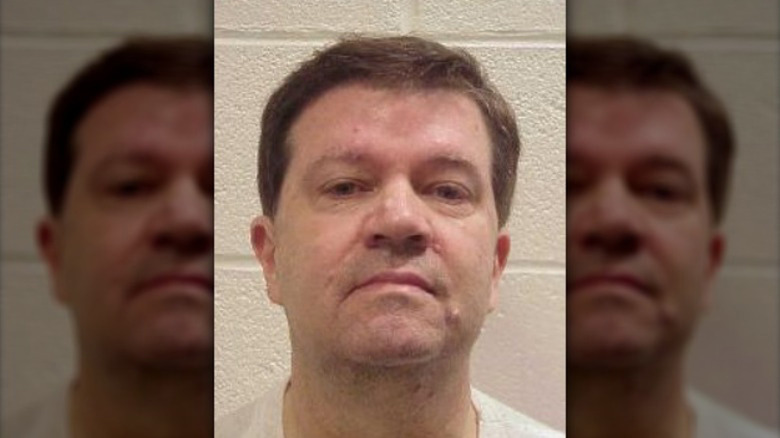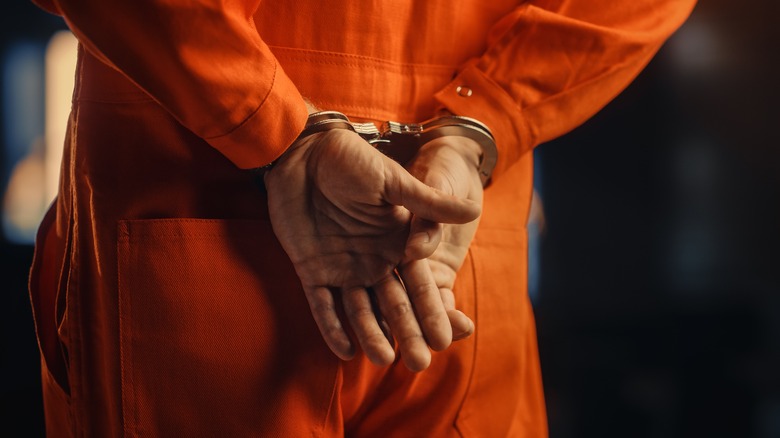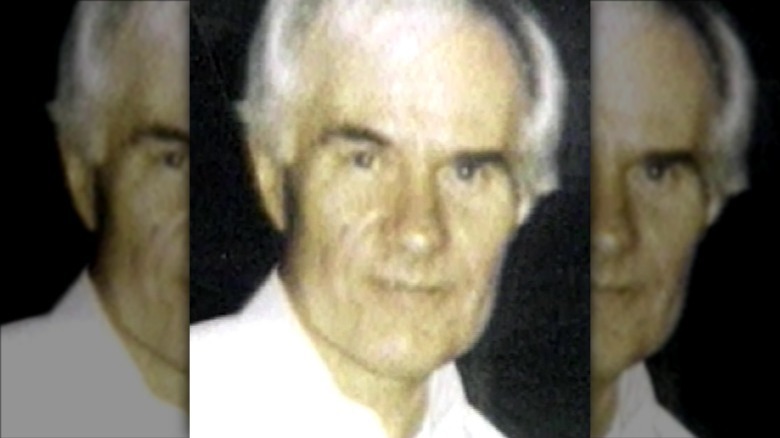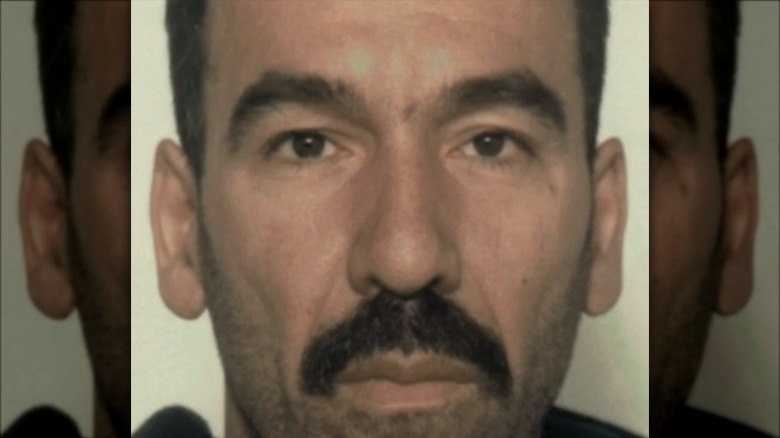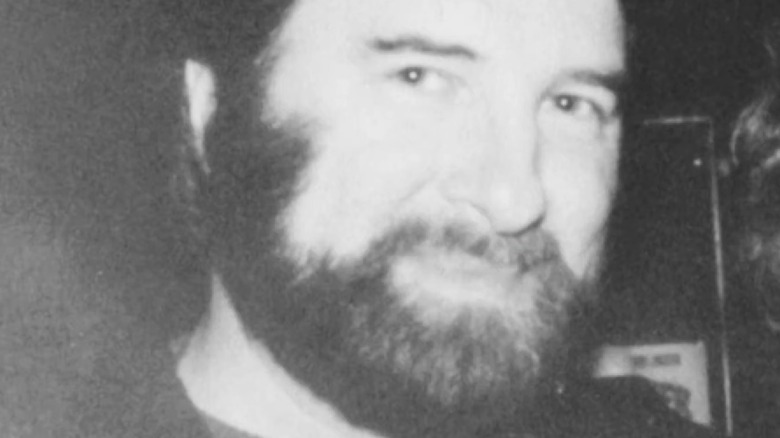The Horrifying Story Of The Last Call Killer
For several years in the early '90s in New York City, there was a predator on the prowl. He struck during the wee hours of the morning when the alcohol had been flowing freely at the Big Apple's gay bars and piano clubs, and while he moved among his prey with a veneer of normalcy, his shocking and brutal methods were straight out of a horror movie. His strikingly ordinary name was Richard Rogers — but among those who feared him and those who sought to catch him, he was known as the Last Call Killer.
Although there was one massive red flag early in his life, Rogers presented himself as a model citizen — he was a friendly neighbor, a dedicated health care employee, and a frequent although unremarkable patron of the nightlife hot spots that were popular among the Big Apple's LGBTQ community. Virtually nobody could have suspected the horrifying double life that he led — and if not for a timely advance in forensics technology and the dogged efforts of one victim's widow, he might have gotten away with his crimes.
Richard Rogers had a normal childhood
According to his cousin John Fillebrown, who spoke with the New York Daily News, Richard Westall Rogers Jr. had an extremely typical childhood. He was the oldest of five children; growing up in Plymouth, Massachusetts, his lobsterman father taught him how to fish, and also to hunt deer and ducks. When Rogers was a tween in the early '60s, his father moved the family to Florida, where he found a good-paying job as a machinist, and it was there that Rogers completed his education. In 1972, he graduated from Florida Southern College, having majored in French and participated in the university's Spanish and Kiwanis clubs.
Throughout his childhood and college years, there was a complete dearth of any red flags to indicate that Rogers had any propensity toward violence. Said Fillebrown, "We never saw anything but a normal and thoughtful person with goals in his life, good habits and a good social life." The first red flag, though, would come in 1973 — and as red flags go, it was a big one.
He was acquitted of a shocking crime in graduate school
After graduating college, Richard Rogers moved to Maine to attend graduate school at the University of Maine at Orono. He lived with a 22-year-old fellow grad student by the name of Frederic Spencer. As was typical of his life up to that point, everything seemed to be going perfectly fine for Rogers — right up until the point at which he was arrested for murdering Spencer with a hammer.
Despite the fact that Spencer had been repeatedly struck in the back of the head with the hammer, smothered with a plastic bag, wrapped up in a plastic tent, and disposed of along a road miles from Rogers' home, Rogers claimed self-defense in Spencer's slaying, saying that Spencer had attacked him with the hammer first. This is incredible in and of itself — but, even more incredibly, Rogers' jury bought it. He was acquitted of the crime, but the State of Maine kept his fingerprints on file — a detail that would prove to be incredibly significant decades after the fact.
He became a respected and caring nurse
Richard Rogers moved to New York City some time after his acquittal, where he attended nursing school. He eventually obtained his nursing license and secured a job at New York's Mount Sinai Medical Center in 1979, where he would remain employed for 22 years. During this time, he was not disciplined by his employer for any reason; he became a surgical nurse and also worked in the hospital's pediatric unit, where he helped to care for children with heart problems.
Obviously, there are no details here that would have clued anyone into the fact of Rogers' violent tendencies, and indeed, those who knew him would later express utter shock that he would be remotely capable of the crimes he committed. A neighbor, Robert Roldan, told the New York Daily News, "Richard was the kind of neighbor that everyone wished to have," and a piano player at a bar that Rogers frequented described him as a "delicate, soft person, very quiet and very gentle," who was always keen to discuss musical theater and his treasured job as a nurse (via the Staten Island Advance). Even if his friends and acquaintances never came into contact with it, though, Rogers' dark side was lurking below the surface — and in one notable case, years before he began terrorizing the Big Apple's gay community in earnest, that dark side nearly got him into some serious trouble.
Another warning sign, another near miss
Although details are sketchy due to records being sealed, Richard Rogers had another run-in with the law in the late '80s — one which troublingly illustrated his capacity for violence toward men. He was charged in 1988 with drugging, tying up, and injuring a 47-year-old man at his Staten Island apartment. Police sources could only offer that the sealing of the records indicated either that Rogers had once again been acquitted, or that the charges had been dropped in the case (via The New York Times).
The New York Daily News also reported on this incident, and in spite of the records being sealed, that publication cited a police source in reporting that Rogers had been charged with unlawful imprisonment and assault, while offering more explicit details in describing the case. Rogers had "[given] the guy some knockout drug, tied him up and had sex with him." It's tough to imagine how Rogers could have dodged that legal bullet — but he did, and a number of men would lose their lives as a result.
The first victim: Peter Stickney Anderson
In May 1991, a maintenance worker made a horrifying discovery at a rest stop on the Pennsylvania Turnpike. According to Elon Green's book "Last Call: A True Story of Love, Lust, and Murder in Queer New York," the man discovered eight unusually heavy trash bags in a plastic barrel — so heavy that he was barely able to lift them. He opened one to take a look inside, and at first, he wasn't sure what he was seeing. "It looked like a loaf of bread," he told Green, "but then I saw freckles."
The bags were eventually found to contain the dismembered remains of 54-year-old Peter Stickney Anderson, a recently divorced, semi-out gay man who was visiting New York from his home in Philadelphia for a political fundraiser. His friends described him as profoundly depressed at the time of his visit. "He just drank and never ate," one anonymous friend told The New York Times in 1993. "Frankly, I didn't expect him to live out the year." Of course, nobody could have predicted his grim fate, but it wouldn't be long before that same fate would befall others.
The second victim: Thomas Mulcahy
In July 1992, the remains of 57-year-old Thomas Mulcahy, a married father of four grown children, was discovered similarly dismembered and stuffed into trash bags in Ocean County, New Jersey. He was also an out-of-towner from Sudbury, Massachusetts, and was in New York for business. He was last seen at the Townhouse bar and restaurant, a popular night spot for gay patrons and the same establishment from which Peter Stickney Anderson had disappeared — and where he presumably had a fateful encounter with Richard Rogers.
Acquaintances told The New York Times in 1993 that Mulcahy had been deeply in the closet, and that none of them had any idea of his bisexuality; outwardly, he was simply a family man and successful sales executive, married for over three decades and active in his church. As one might imagine, his shocking murder shook those who knew him to the core. Said his cousin Brian Manning, a Catholic priest, "He died a very tragic, very violent death. It was very unsettling."
The third victim: Anthony Morrero
In contrast to Richard Rogers' other victims, 44-year-old Anthony Morrero was not known to hang around piano bars; at the time of his disappearance, he had been working as a sex worker at New York's Port Authority Bus Terminal as a means to support a vicious crack habit. His life had been nothing if not troubled. Also speaking with The New York Times in 1993, his brother Louis Marrero recalled a tryout as a pitcher for the Philadelphia Phillies as perhaps being the high point of Anthony's life. A failed marriage in 1980, an introduction to crack cocaine, and an inability to hold down a regular job had led him into the sex trade.
According to police investigators, Anthony Marrero was last seen hopping between several gay bars in Manhattan, a scene in which he was a little out of his element — which might have been a factor that led him to his death. Like Rogers' previous victims, his body was discovered in May 1993, dismembered and divided between several garbage bags, which were then deposited into trash cans around Ocean County, New Jersey.
The fourth victim: Michael Sakara
Richard Rogers' final known victim, Michael Sakara, was discovered in July 1993, in a grim ending to what by all accounts was a life joyously lived. An openly gay man, Sakara had been out for a long time and had been in a committed and monogamous relationship for nine years. A typesetter at the New York Law Journal by profession, Sakara was a big, burly, friendly man, fond of ending each night at the Five Oaks piano bar with a rendition of the Billie Holliday classic "I'll Be Seeing You." He was last seen at that establishment around 4 a.m. on a Friday morning; the next day, his head and arms were found in two separate trash bags in Haverstraw, New York.
A friend of Sakara, theater producer Peter Catanese, was the last one to see Sakara alive. He told The New York Times in the 1993 piece, "I waved to him and said goodbye. I wish I could have said something." Barbara Ross, a bartender at the Five Oaks, said, "This has been the worst week I've had in my entire life. Everyone is determined that whoever did this gets caught." The law would indeed catch up to Rogers — but not for eight long years.
The trail goes cold
Due to the glaring similarities between the murders of Richard Rogers' four known victims, police came to strongly suspect that they were dealing with a serial killer. Indeed, a task forcewas even formed with the aim of snaring the culprit — but said task force seems to have immediately run up against a lack of evidence. What fingerprints police had been able to obtain from the crime scenes weren't able to be identified, and with virtually no other physical evidence to go on, the task force quickly hit a wall. It was disbanded by the end of 1993.
Between that time and Rogers' eventual arrest, no murders were linked to him — although in an interview with A&E, Elon Green revealed that in 1998, a man named Joe Gallagher was picked up by Rogers and subsequently drugged but was able to convince his abductor to set him free upon awakening, perhaps because Gallagher had taken the precaution of calling his partner to let him know where he was going. Perhaps it was this close call, five years after his last murder, that prevented Rogers from resuming his murderous pastime.
A victim's widow jump starts the investigation
There was one person in particular who refused to let the case of the Last Call Killer join the ranks of forever unsolved murders: Margaret Mulcahy, the widow of Thomas Mulcahy. She was presumably aware of the limitations that had hindered the first task force, and according to Elon Green, she was determined that investigators use whatever new technology had become available to overcome those limitations. "Detectives told me that if Margaret hadn't given them 'a kick in the pants' after the case had been cold for some years, they probably would not have given it another look," Green told A&E.
The author went on to describe how Mulcahy had resorted to hiring a private investigator to track down leads surrounding her husband's murder and had gone so far as to directly place a phone call to the head of the original task force to demand a meeting. Green says that this pressure prompted the authorities to start thinking about new approaches to the case — and in doing so, they happened upon a brand-new technology for the time, one that would quickly help to crack it.
Richard Rogers' luck finally runs out
The technological innovation that finally put Richard Rogers behind bars: vacuum metal deposition, or VMD, which is a technique used to enhance fingerprints that have been obtained from less-than-ideal surfaces — such as, for example, plastic bags. This tech had recently come online at police departments in Toronto, Canada, and fortunately, the New Jersey police had a decent working relationship with said agencies, according to Elon Green. The author described for A&E how this tech was used to collect much more viable prints than had previously been collected from the trash bags which Rogers had used to dispose of his victims' body parts.
The authorities were then finally able to obtain a match with the fingerprints that were taken from Richard Rogers in his 1973 murder case, prints which had been on file in Maine for 27 years. "The hero of the story is ... the person who took Richard Rogers' fingerprints in 1973, after his arrest for the Fred Spencer killing," Green said. "Because if those hadn't been beautiful prints — and they are, I've seen them — [the VMD technology] wouldn't have mattered."
On May 28, 2001, police approached Rogers at Mount Sinai, with a phony story about how he was a potential credit card fraud victim. When they began questioning him about the murders of his four victims, Rogers clammed up and requested an attorney. He was then arrested, with bail set at a cool $1 million.
Justice is served
After Richard Rogers' arrest, investigators searched his home for further evidence — and while the evidence they found proved to be circumstantial, it was nothing if not compelling, and painted a pretty compelling picture. According to court documents obtained by The New York Times during the sentencing phase of Rogers' trial in 2006, this included carpet fibers which were consistent with those found with the body of Thomas Mulcahy; a bottle of Versed, a powerful sedative that could easily render one unconscious; and, most disturbingly, several photographs of men, none of which were known to investigators, upon which Rogers had drawn stab wounds.
Rogers was tried only for the murders of Mulcahy and Anthony Marrero, although prosecutors were allowed to present the jury with details of the other two victims' murders, as well. Found guilty of both crimes, Rogers was sentenced to two consecutive life sentences, which he is serving in the New Jersey State Prison in Trenton. In his conversation with A&E, Elon Green revealed that although Rogers turned down the author's request to speak to him, he has been able to glean a few details of his life in prison: He likes the roast beef from the prison kitchen, is an avid watcher of news, and likes to write letters. "He doesn't seem at all unhappy," Green said. "And he maintains his innocence."
